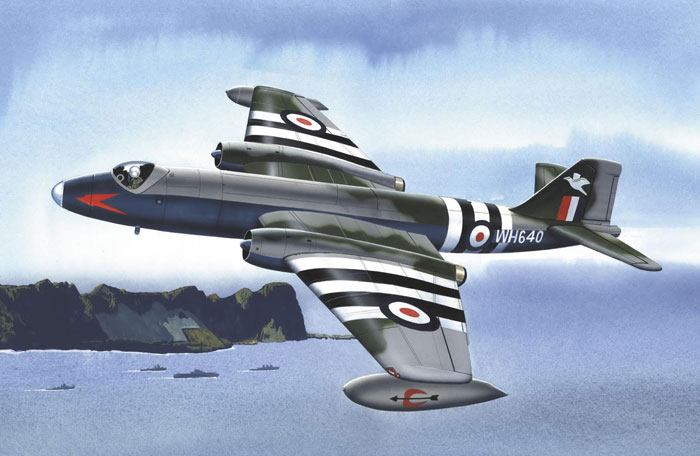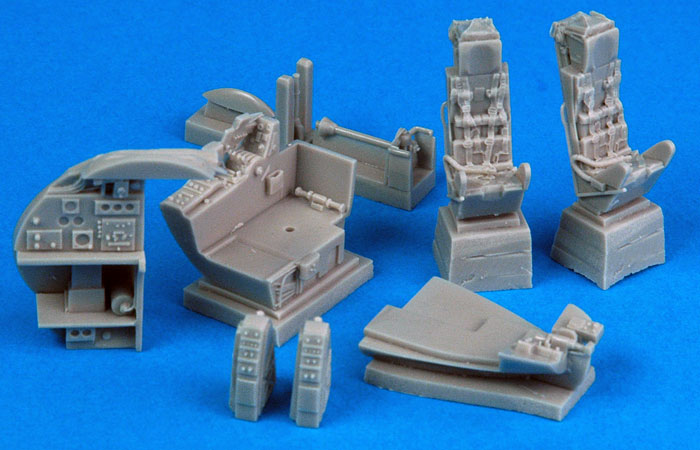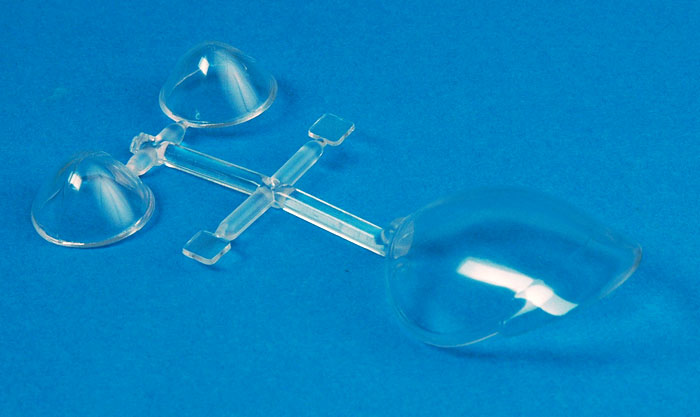|
English Electric Canberra

Classic Airframes, 1/48
scale
S
u m m a r y
|
| Catalogue Number: |
4126 - English Electric Canberra
B.Mk.2 |
| Scale: |
1/48 |
| Contents and Media: |
42 parts in grey styrene; 21 parts in grey colored
resin; 8 clear injection molded parts; printed clear
acetate sheet (instruments); instructions; decal sheet and
painting guide for three aircraft. |
| Price: |
MSRP
USD$60.00
Available online
now from Hannants for GBP£39.95 |
| Review Type: |
FirstLook |
| Advantages: |
First time available as an injection-moulded kit;
large and impressive; excellent surface detail including
crisply recessed panel lines, very high quality plastic moulding;
impressively detailed resin parts; generally very good fit; separately packed clear, photo-etched and resin parts; interesting and varied marking choices. |
| Disadvantages: |
Some modelling experience helpful for preparing
resin parts; a little extra time required for alignment and perfect fit. |
| Recommendation: |
Highly Recommended |
Reviewed by
Brett Green

Classic Airframes' 1/48 scale Canberra B.Mk.2 will be available online from Squadron
The English Electric Canberra was a groundbreaking
aircraft when it entered service in the early 1950s. The Canberra set
and held many altitude, distance and speed records in its early years.
In addition to widespread and long service with the Royal Air Force, the
English Electric Canberra was exported to many countries including
Australia, New Zealand, Sweden, France, West Germany, India, Pakistan,
Rhodesia, Ethiopia, Argentina, Chile, Ecuador, Peru and Venezuela.
The Canberra's service record was remarkable in its
longevity, spanning from the Suez crisis to Vietnam to the Persian Gulf.
In fact, the final Canberra PR.9s in RAF service are only due to retire
this year.
The Canberra has made several appearances in 1/48
scale before, but never as an injection moulded kit. Falcon of New
Zealand released a basic but accurate vacform Canberra during the 1980s.
War Eagle also offered a white metal update set to add some essential
details to this kit. More recently, Aeroclub released a multi-media
Canberra featuring vacform wings and fuselage, injection-moulded nose
cone and detail parts, supplemented with nicely detailed resin and white
metal. I have one of these excellent, but currently unavailable, kits as
yet unbuilt in my stash.
I was delighted to hear that Classic Airframes
would be adding a family of Canberras to their lineup. The very word "vacform"
can strike fear into the heart of many modellers, so Classic Airframes'
injection-moulded model would significantly broaden the opportunity to
actually build one of these sleek Cold War bombers.
Classic Airframes' 1/48 scale Canberra B.Mk.2 kit
comprises 42 parts in grey styrene; 21 parts in grey colored resin; 8 clear injection molded parts; instructions; plus a decal sheet and painting guide for
four aircraft.
Plastic parts are presented to a very high standard.
Moulding quality is excellent, and the highly polished finish does not
reveal any moulding imperfections on the exterior surfaces. This shiny
surface will be especially useful for modellers who plan a High Speed
Silver finish to their Canberra. Panel lines are crisply recessed,
consistent and very fine.

Click
the thumbnails below to view larger images:
The long fuselage is split into two halves for the main section and
another two for the nose. This suggests that we will see the tandem
cockpit versions of the Canberra at some later date. The slab-like wings
are supplied in two halves (upper and lower) each.
Although there are no locating pins on the main parts, the wings are reinforced with
two plastic spars spar. This will add rigidity
and ensure the correct dihedral. There are a few tall ejector pins on
the inside surfaces of the wings that should be sliced off prior to
assembly, but the remaining scars will not be visible after assembly.
The inner lip of the intakes also have ejector pin marks. These need a
bit more time and care in cleaning up.
Resin parts are very nicely detailed. The bulk of these details are
for the cockpit, including two gorgeous Martin-Baker ejection seats, but
the undercarriage bays, wheels and intake fans / starter bullets are
also supplied in resin.

The front wheels are cast with mudguards on top of the tyres. Not all
Canberras were fitted with these mudguards, so check your references
before assembly. If your subject was not equipped with mudguards it will
be a simple matter to sand them off before painting.
The gear bays are immaculately detailed with structural features and
wiring. It is just a shame that so little of this detail will be seen
under the low-slung Canberra airframe.
The starter bullets are the short style usually seen on the B.2
Canberra, typical for Avon Mk.1 engines.

Some of the parts are cast onto stout blocks so a combination of a
good razor saw and caution will be required when preparing these resin
components.
Clear parts are well moulded and relatively distortion free - quite
an accomplishment considering the fishbowl configuration of the canopy!
A choice of nose-cone styles is offered. The clear parts do respond very
well to a bath of Future floor polish.

The shape of the model looks accurate compared to published plans and
contemporary photographs.
Markings
Three interesting marking options are offered on the instructions:
-
Canberra B.2, 10 Squadron RAF
Nicosia, Cyprus during the Suez Crisis, Autumn, 1956. This aircraft
is finished in Medium Sea Grey and Light Slate Grey on the upper
surfaces, with PRU underneath and Aluminium tip tanks. Large black
and white theatre stripes on the wings and fuselage complete this
striking scheme.
-
Canberra B.2, 44 Squadron RAF
Nicosia, Cyprus during the Suez Crisis, Autumn, 1956. This subject
is finished in overall Aluminium paint (modellers note, this is not
natural metal), with pale yellow and black theatre stripes.
-
Canberra B.2, USAF Production Pattern
Aircraft, March 1951. Moe variety here with Medium Sea Grey upper
surfaces and black lowers. Stars and bars in four positions, plus
large "USAF" lettering on top and bottom of wings.
Decals are printed in perfect register, and colours look good.
Classic Airframes' 1/48 scale Canberra is a big, impressively
detailed, accurately shaped kit. With a recommended price of USD$60.00,
it is a bargain too, especially considering the extensive resin
included.
The relatively small parts count reflects the simple design of the
airframe, but does not compromise detail. It certainly will speed
construction though!
Granted, this model will need a little more cleanup
and preparation of parts than a long-run release from Tamiya or Hasegawa.
Also, the lack of locating pins will call for extra care and
dry-fitting. In other words, modelling skills are required, but
anyone who has already built a Classic Airframes kit should not have any
trouble coming up with a great result straight from the box.
I have already built Classic Airframes' 1/48 scale Canberra and can
confirm that fit is generally very good. You can
follow
this link to see construction comments and progress photos. With a little extra
time spent on preparation and alignment, it was a real pleasure to work on.
Highly Recommended to experienced modellers.
Thanks to
Classic Airframes for
the review sample.
Classic Airframes
kits are available worldwide through hobby retailers and from
Squadron.com
Review and Images Copyright © 2006 by
Brett Green
Page Created 28 April, 2006
Last updated 30 April, 2006
Back to HyperScale Main Page
Back to Reviews Page
|
Home | What's
New | Features
| Gallery |
Reviews | Reference
| Forum
| Search